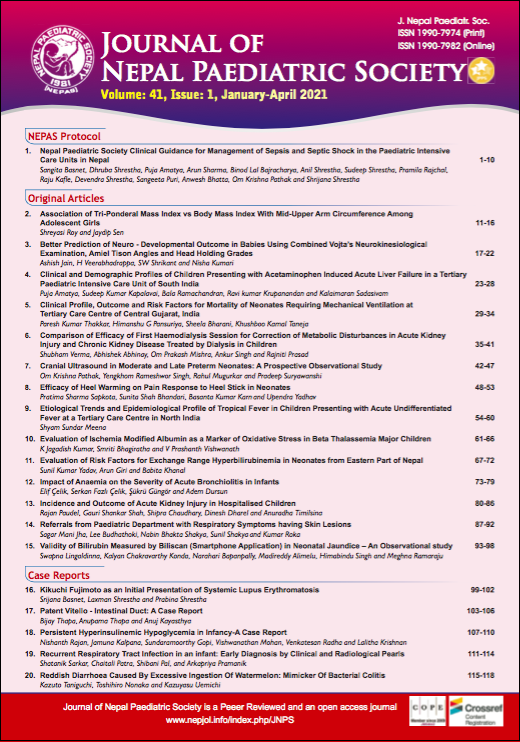Efficacy of Heel Warming on Pain Response to Heel Stick in Neonates
DOI:
https://doi.org/10.3126/jnps.v41i1.30786Keywords:
Heel stick, Heat application, Neonates, PainAbstract
Introduction: Heel prick is one of the commonest procedures carried out in the hospitalised newborns. Pain is a subjective experience for which the neonates, infants and children respond with behavioural reactions. Applying hot pack to the skin surface causes proximal blood vessels to dilate due to the raised temperature which may decrease the pain perception in neonates. We intended to study the effect of heel warming during heel prick in perception of pain in neonates.
Method: An experimental study was conducted among neonates admitted in paediatric wards of BPKIHS. Total 92 participants undergoing heel prick/stick were selected by consecutive sampling technique and allocated randomly to experimental group and control group. Warmer was applied to the heel of the baby for three to five minutes which provided the baby’s heel with the warmth of 38°C to 40°C prior to heel stick in experimental group only. Newborn’s pain level was assessed in both experimental and control group through The Neonatal Infant Pain Scale (NIPS). Mann Whitney test was used to compare means of pain score between experimental and control groups.
Results: The mean pain score among experimental group was 1.39 and in control group was 2.20. Experimental group showed significantly lower pain (p < 0.001) compared to the control group. Application of warmth before heel stick caused reduction in pain.
Conclusions: The findings suggest that heat application prior to heel stick is effective in reducing pain in newborns.
Downloads
Downloads
Published
How to Cite
Issue
Section
License
Authors who publish with this journal agree to the following terms:
Authors retain copyright and grant the journal right of first publication with the work simultaneously licensed under a Creative Commons Attribution License that allows others to share the work with an acknowledgement of the work's authorship and initial publication in this journal.
Authors are able to enter into separate, additional contractual arrangements for the non-exclusive distribution of the journal's published version of the work (e.g., post it to an institutional repository or publish it in a book), with an acknowledgement of its initial publication in this journal.
Authors are permitted and encouraged to post their work online (e.g., in institutional repositories or on their website) prior to and during the submission process, as it can lead to productive exchanges, as well as earlier and greater citation of published work (See The Effect of Open Access).



